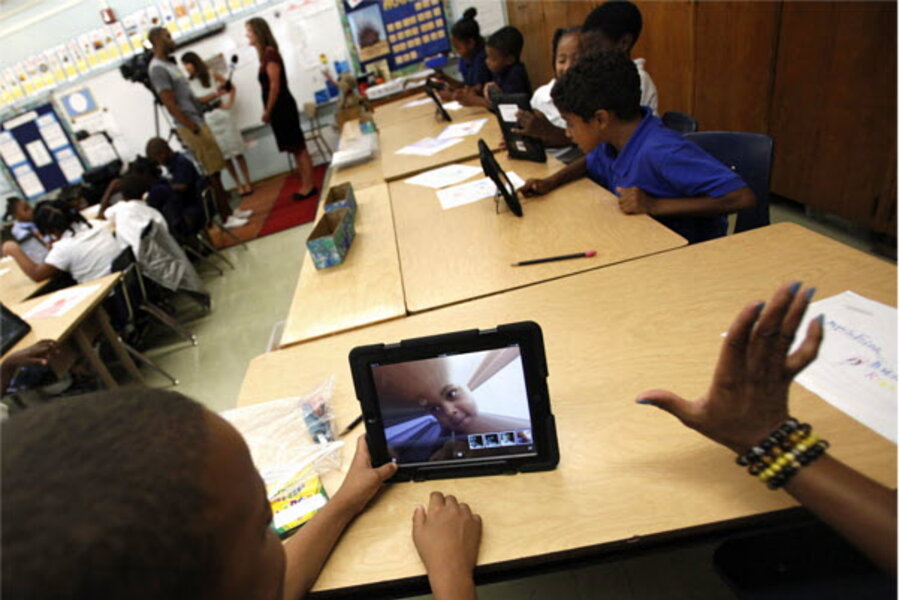$1 billion iPad giveaway at L.A. schools: Bad idea or poor execution?
Loading...
| Los Angeles
The fall school session is barely underway and already the nation’s second-largest district is getting an F from educators and community members alike.
The Los Angeles Unified School District (LAUSD) is taking flak for what many say are predictable missteps in its ambitious $1 billion plan to give an iPad to every student in the district.
As 26 of 47 schools in the first phase have begun handing out tablets, students have devised ways around security measures designed to prevent unfettered online access. Further, after some 69 iPads went missing during a spring trial run, families have begun issuing complaints that the policy on liability for loss, theft, and damage is unclear.
Teachers also have voiced concerns about the time involved in checking the iPads in and out of the classrooms.
In response, LAUSD officials have called a temporary halt to the full program. They also have announced an interactive community hearing to be broadcast Thursday over local television to allow families to question school officials directly.
“With a program of this magnitude, I would expect many legitimate questions,” says LAUSD spokesman Tom Waldman, noting that more than 600 campuses serve the district’s 650,000 students. “There are sure to be some initial wrinkles to iron out,” he adds.
However, educators who have tracked school districts around the country suggest that Los Angeles appears to be making avoidable mistakes.
“The computers are easy to hack, have no keyboards, which the students need, and come with no specific insurance plan should they be lost or stolen,” says Larry Sand, president of the California Teachers Empowerment Network, an online advocacy group.
District officials belatedly committed additional funds to provide wireless keyboards for the tablets. But, says Mr. Sand, “this was obviously a poorly thought out idea.”
Formally known as the Common Core Technology Project (CCTP), the tablet rollout is being promoted as “a major capital investment in technology-enabled classrooms.” The district says the project is helping to ready schools for Common Core State Standards, protocols adopted by 44 other states.
Noting what he calls the digital divide between many students, Mr. Waldman says the project “is especially targeting the economically disadvantaged students in our district.”
But this equation between technology and achievement for disadvantaged students has led some school districts astray, says Donna Celano, a professor of communication at La Salle University in Philadelphia.
“Expensive programs giving home computers and other information technology does not result in any significant achievement gains for low-income children,” she adds via e-mail. In addition, she says, her own research indicates that “mere access to technology is not enough, when real differences stem from differences in literacy achievement.”
Technology educators often exist in “a self-reinforcing community that is often distant from the everyday realities of the rank-and-file practitioners of K-12 education,” says Renee Hobbs, professor and founding director of the Harrington School of Communication and Media, at the University of Rhode Island.
She notes that she has been an active participant at education and technology conferences for two decades, and says the atmosphere of excitement over the possibilities of innovation can sometimes overshadow a more measured approach to curriculum needs.
“These technology directors are fascinated by the newest gadgets, and they just love them,” she says, adding that if you get a whole roomful of them, “they just seduce one another.” While that dynamism and enthusiasm is what it takes sometimes to move a new idea through entrenched bureaucracies, Professor Hobbs says, “it can interfere with real strategic planning and the kind of baby steps really needed.”
District officials would do better to involve the students themselves, suggests educator Jerusha Conner, from Villanova University in Philadelphia.
“Had students been included in reform discussions with LAUSD administrators, it seems likely not only that they would have anticipated and therefore helped to prevent the unintended consequences of this initiative, but also that they might have helped district officials understand the drawbacks of software blocking technologies,” she says via e-mail.
“The agency and ingenuity of students should not be underestimated, as they were in this case,” she adds, “but harnessed so that students become critical partners in developing and implementing the reforms that students themselves see as needed, sustainable, and most conducive to their learning and development.”





